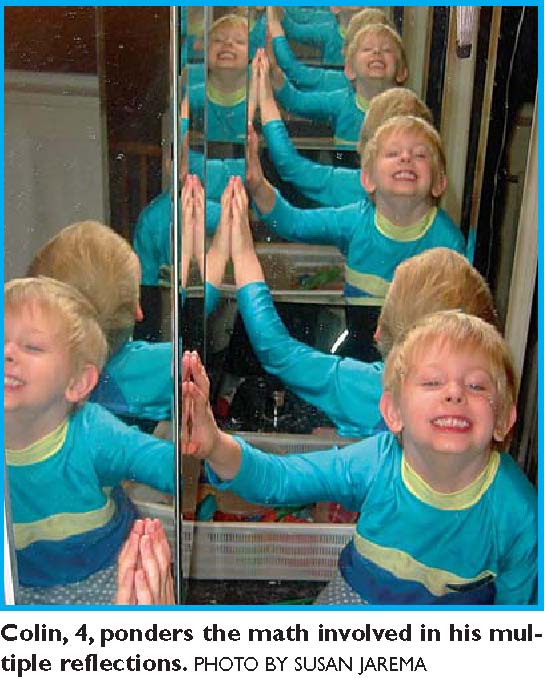Susan Jarema doesn’t have to look far to find Math Moments. Her two children, Maya, 6, and Colin, 4, provide them on a daily basis with their imaginative questions: “How many slugs are in Canada?” “How many stars are in the universe?” “How many termites are in a termite hill?” “How many bacteria are inside me when I’m sick?”
 Moments before bedtime one evening, Colin wonders how many seconds he has lived. Susan can’t resist pulling out a calculator to answer the question: More than 100 million seconds! Not to be outdone in bedtime extensions, Maya suggests this scenario: “If we had 27 kids and they each fought with each other once, how many fights would that be?”
Moments before bedtime one evening, Colin wonders how many seconds he has lived. Susan can’t resist pulling out a calculator to answer the question: More than 100 million seconds! Not to be outdone in bedtime extensions, Maya suggests this scenario: “If we had 27 kids and they each fought with each other once, how many fights would that be?”
Numbers like million, billion, trillion and googol (a one with a hundred zeros) are fascinating to children of all ages. Parents can draw upon them to help kids understand the basis of our number system: each additional zero multiplies the value 10 times.
Here’s one way to get a handle on big numbers:
- Look for a thousand of some common object (blades of grass, for instance, or tufts of carpeting).
- Write the numeral 1,000.
- Now imagine a thousand of these thousands (1,000 X 1,000) to get a million:1,000,000. A thousand million (1,000 X 1,000,000) is a billion: 1,000,000,000. A thousand billion (1,000 X 1,000,000,000) is a trillion: 1,000,000,000,000. Don’t be surprised if your child wants to know how many grains of sand are in the world! (One answer: not as many as stars in the universe!)
It is helpful to have “benchmarks” that make large numbers concrete. One family has discovered a thousand bricks in their patio; 10,000 seats in their section of a baseball stadium; 100,000 people living in their suburb. For one million, they taped a large piece of graph paper with 1,000,000 tiny squares onto a wall of their garage.They now have a way to visualize big numbers that often appear in books, newspapers, TV, radio – or in everyday conversation.
Inevitably, children will wonder about infinity. It’s not a number because it doesn’t represent a particular amount, but it is a mathematical concept that stretch es the imagination. In his parents’ bathroom, Colin notices that two mirrors placed in front of each other create a pattern of reflections that seems infinite because “it goes on forever and ever and ever and ever…” Luckily for Susan, on this evening he doesn’t try for infinite bedtime extensions.
Instead, he kisses her goodnight and sweetly says,“Mom, I’ll love you ’til infinity.”
Math Moments™ creator David Schwartz spends much of his time finding unusual, whimsical ways to make math and science come alive for kids and teachers, both through writing and through speaking at schools and conferences. He has written nearly 50 books for kids, including How Much Is a Million? and the “Look Once, Look Again” series.
Share Your Math Moments
David Schwartz would love to include your family’s Math Moments in this column. Send your stories and photos, along with your name and mailing address. David will award a signed copy of one of his books to those whose submissions he uses in this column.